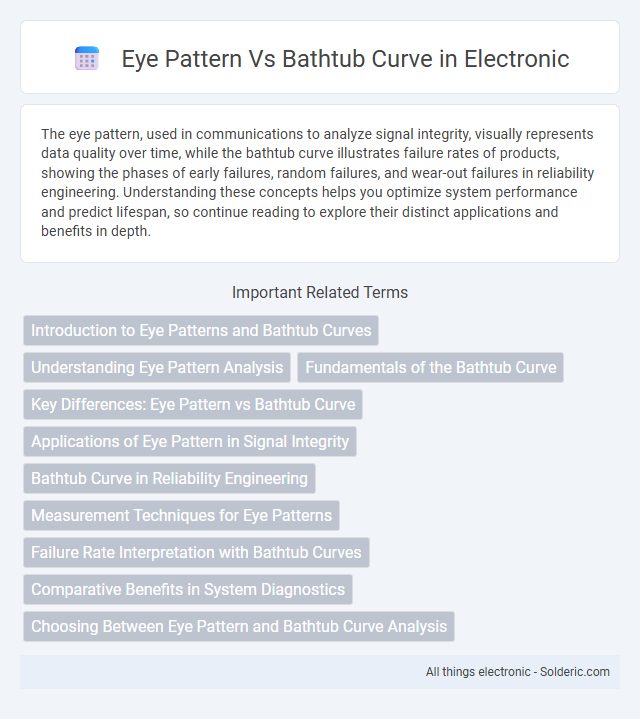The eye pattern, used in communications to analyze signal integrity, visually represents data quality over time, while the bathtub curve illustrates failure rates of products, showing the phases of early failures, random failures, and wear-out failures in reliability engineering. Understanding these concepts helps you optimize system performance and predict lifespan, so continue reading to explore their distinct applications and benefits in depth.
Comparison Table
| Aspect | Eye Pattern | Bathtub Curve |
|---|---|---|
| Definition | Visual representation of digital signal quality in communication systems. | Graph showing failure rate over product life cycle stages. |
| Purpose | Analyze signal integrity and timing errors in data transmission. | Identify reliability phases: infant mortality, normal life, wear-out. |
| Application | Telecommunications, high-speed digital systems testing. | Reliability engineering, product life testing, failure analysis. |
| Data Representation | Waveform overlap creating an "eye" shape showing signal clarity. | Plot of failure rate (y-axis) vs. time or usage (x-axis). |
| Key Metrics | Eye height, eye width, jitter, signal-to-noise ratio. | Failure rate, time intervals: early life, steady state, wear-out. |
| Interpretation | Wider eye opening means better signal quality. | Curve shape indicates reliability phases and failure causes. |
Introduction to Eye Patterns and Bathtub Curves
Eye patterns visually represent signal integrity in high-speed digital communications by displaying waveform distortions, jitter, and noise effects on data transmission quality. Bathtub curves characterize the failure rate of electronic components over time, highlighting early failures, a stable middle period, and wear-out phases crucial for reliability assessment. Understanding both tools aids engineers in optimizing system performance and predicting component lifespan.
Understanding Eye Pattern Analysis
Eye pattern analysis provides a visual representation of digital signal integrity by overlapping multiple signal waveforms to reveal timing jitter, noise, and distortion within high-speed communication systems. The bathtub curve, often used in reliability engineering, illustrates the failure rate over time, highlighting early-life, random, and wear-out failure periods, which contrasts with the instantaneous signal quality insights given by eye diagrams. Understanding your system's eye pattern can help identify signal degradation and timing issues before they affect long-term performance, complementing lifecycle improvements guided by bathtub curve analysis.
Fundamentals of the Bathtub Curve
The Bathtub Curve illustrates the failure rate of products over time, divided into three phases: high initial failure (infant mortality), a low and stable failure rate (useful life), and an increasing failure rate due to wear-out. This model helps predict reliability and maintenance needs by showing how failures vary from early use to the end of a product's lifecycle. Understanding this fundamental concept can improve your approach to product testing and lifecycle management strategies.
Key Differences: Eye Pattern vs Bathtub Curve
Eye pattern analysis visually represents digital signal integrity by displaying voltage over time, highlighting timing jitter and noise in high-speed communication systems. The bathtub curve illustrates failure rate over time, identifying phases of early failure, constant failure, and wear-out in reliability engineering. Understanding these key differences helps you optimize both signal quality and product lifespan in electronic design and testing.
Applications of Eye Pattern in Signal Integrity
Eye patterns provide critical visual insights into signal integrity by revealing timing jitter, noise margins, and signal distortion in high-speed communication systems. Your ability to analyze these patterns helps identify issues like intersymbol interference and crosstalk, enabling effective troubleshooting and optimization of data transmission quality. Unlike the bathtub curve, which models failure rates over time, eye patterns directly assess the real-time performance of digital signals.
Bathtub Curve in Reliability Engineering
The Bathtub Curve in reliability engineering illustrates the failure rates of products over time, highlighting three distinct phases: early failures, a stable period of low failure rates, and increasing wear-out failures. Unlike the Eye Pattern used in signal integrity to analyze timing and jitter in communication systems, the Bathtub Curve focuses on predicting product lifespan and maintenance schedules. Understanding your system's Bathtub Curve can optimize reliability strategies and reduce unexpected downtimes.
Measurement Techniques for Eye Patterns
Eye pattern measurement techniques utilize high-speed oscilloscopes to capture voltage over time, revealing signal integrity and timing accuracy in digital communication systems. These measurements assess amplitude, jitter, and noise by overlaying multiple bits of data, providing a visual representation crucial for optimizing transmission quality. Precise eye diagram analysis helps detect inter-symbol interference and other distortions, complementing the bathtub curve's error rate prediction for comprehensive performance evaluation.
Failure Rate Interpretation with Bathtub Curves
Failure rate interpretation with bathtub curves reveals how reliability evolves through three distinct phases: early failure period, characterized by a decreasing failure rate due to initial defects; the steady-state period, where the failure rate stabilizes and remains relatively constant; and the wear-out period, marked by an increasing failure rate as components age. This model aids in predicting product lifespan and scheduling maintenance by understanding failure dynamics. Unlike eye patterns in signal integrity analysis, which focus on signal quality and timing, bathtub curves provide critical insights into long-term reliability and failure prediction.
Comparative Benefits in System Diagnostics
Eye pattern analysis provides real-time visualization of signal integrity, enabling precise identification of timing jitter and noise in high-speed digital communications. The bathtub curve offers a statistical failure rate over time, highlighting reliability and wear-out mechanisms in electronic components. Combining eye pattern data with bathtub curve trends enhances system diagnostics by linking immediate signal quality issues to long-term reliability predictions, improving fault detection and preventive maintenance strategies.
Choosing Between Eye Pattern and Bathtub Curve Analysis
Eye pattern analysis offers real-time visualization of signal integrity in high-speed digital communication, making it ideal for diagnosing jitter, noise, and timing errors. Bathtub curve analysis provides a statistical view of bit error rates over time, valuable for assessing overall reliability and signal performance under various conditions. Choosing between these methods depends on whether the priority is immediate signal quality assessment (eye pattern) or long-term error rate evaluation (bathtub curve).
eye pattern vs bathtub curve Infographic

 solderic.com
solderic.com